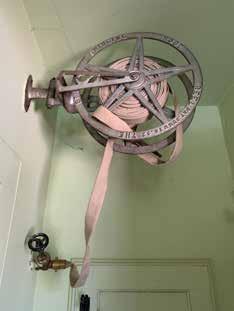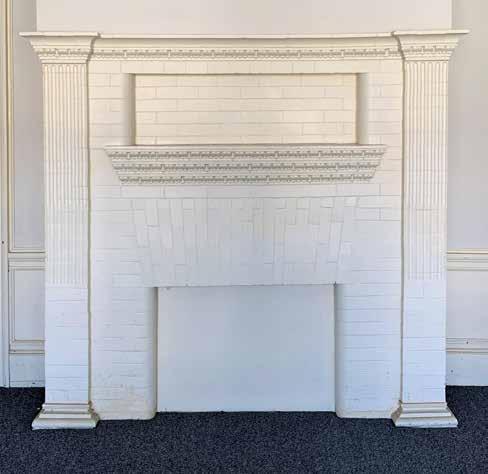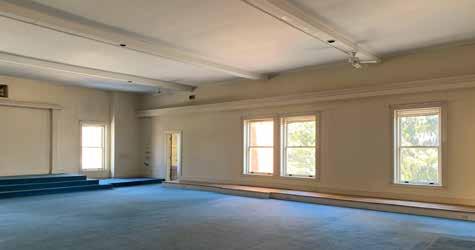
7 minute read
Preserving Saratoga
New Li�e �or Lodge: 687 North Broadway
preservingSARATOGA
WRITTEN AND PHOTOGRAPHED BY (UNLESS OTHERWISE NOTED)
SAMANTHA BOSSHART, SARATOGA SPRINGS PRESERVATION FOUNDATION
Set back behind large pine trees is a rather imposing brick building at 687 North Broadway. One may wonder if it is a large residence or if it was built for some other purpose. Most in Saratoga Springs remember it as the Masonic Lodge. It, like many other masonic buildings across the country, seems so mysterious. A place for the fraternal organization, the Freemasons, to conduct business. However, that was not the first chapter of this property’s story nor is it the last. The property of 687 North Broadway was originally part of the property that was owned by William A. Shepard, a village leader who was one of the founders of the Historical Society of Saratoga. His summer residence, known as “The Gables,” was located at 677 North Broadway, no longer extant. The deed records that Henry G. Ludlow purchased 687 North Broadway from the estate of William A. Shepard in 1902. Henry is noted for inventing the Ludlow valve, a straight-way stop valve with sliding gate and separate wedge that was useful in regulating the flow of gas, water, steam, or oil. He founded the Ludlow Valve Manufacturing Company in 1861. Located in Troy, it was one of the largest valve and fire hydrant manufacturers in the country. Henry and his family would spend summers in Saratoga Springs, often staying at the Rickard Cottage at 632 North Broadway.

A 1939 historic photograph of 687 North Broadway, provided by the George S. Bolster Collection, Saratoga Springs History Museum.

Ludlow Valve Manufacturing 1874 Letterhead of Annual Company Meeting from FireHydrant.org (above); Original fire suppression system at 687 North Broadway (right).

Due to failing health, he asked his son Henry S. Ludlow, also known as Harry, to abandon his ministerial ambitions and return to assist with the management of the company. Harry held several different positions at the company until Henry sold the business. Henry’s health declined due to his age and in 1900, “he fell and sustained a concussion of the brain, which resulted in a giving way of the mind,” according to his obituary in The Troy Times on December 27, 1904.
Most likely due to his father’s failing health, it was Harry who hired R. Newton Brezee, a prominent architect in
Saratoga Springs, to design a new 26 room summer Historic photo of the Ro-Ed Mansion showing the rear additions, residence and carriage house. According to tax records the including the dining room, and gardens. Photo: George S. Bolster Collection, Saratoga Springs History Museumhouse was completed in 1903 and the carriage house the following year. The Saratogian dated November 29, 1904, noted “Harry S. Ludlow, of Troy, a well-known Summer Saratogian, today visited the village and inspected his North Broadway property.” The two-and-half story house is unique because of its Gothic Revival influence – steeply pitched cross-gables with shaped parapets and pointed-arched windows with unique decorative moldings made of brick. The carriage house, today 228 Woodlawn Avenue, has the same decorative features, but is clad in wood shingles. Understanding the importance of fire suppression, may explain why the house is constructed of brick, the basement has tin ceilings, and there once was a system of valves and fire hoses.
In 1896, Harry founded The Troy Record newspaper with a group of business men. He was the paper’s first treasurer and later served as president for 32 years. Harry was loyal and generous supporter of the Young Men’s Christian Association. He served on the state board and was a director of the Troy YMCA and later the Saratoga Springs YMCA. He also built Camp Van Schoonhoven, in honor of his wife’s family, on Burden Lake, and Camp Dudley on Lake Champlain. He was also instrumental in establishing a YMCA in Havana, Cuba. In addition to being dedicated to the YMCA, he was a director of three banks. In 1908, he married Margery Nash and had two daughters, Dorothy and Margery. He later married Mary Van Schoonhaven in 1916. Various newspapers shared that he and his wife Mary loved to entertain at their summer residence and travel around the world. Harry passed away in 1938. Mary married Harrie M. Levengston in 1940. Harrie, who was credited with building the first therapeutic mineral baths in Saratoga Springs and a pioneer auto dealer with locations in Saratoga Springs, Syracuse, and Utica, moved from his home at 115 Circular Street to 687 North Broadway. The year after Harrie passed away she purchased the former famed singersongwriter Chauncey Olcott estate, Inniscarra, at 251 Clinton Street and sold the property to the Masonic Hall Association in 1953 for “approximately $10,000” according to The Saratogian. At the time of purchase, the Masonic Hall Association was comprised of members of Rising Sun Lodge 108, F & AM; Rising Sun Chapter 131, RAM; Saratoga Chapter 131, OES; Saratoga Court 55, Order of the Amaranth; Cryptic Council 37, R & SM; Washington Commandery 33, Knight of Templar; and Masonic Club. Prior to purchasing 687 North Broadway, the Masons were considering constructing a small new building on Broadway. The Freemasons is one of the oldest and largest fraternal organizations in the world. Their origins date back to the fraternities of stone masons that supported one another as craftsmen in the Middle Ages. Members uphold strong values and community service. Lodges were constructed throughout the world. The Freemasons have been in this area since 1809, occupying several buildings on Broadway. History, rituals, and symbolism are important to the organization. One set of pocket doors. A similar set was discovered in the walls.


Bedrooms on the second floor were removed to create the large meeting room for the Masons.

The attic shows remnants of the rooms that existed prior to the ceiling being raised for the meeting room. Original hardware remains throughout the house.

The grand entry hall with fireplace, decorative columns, and the existing staircase. Notable Freemasons include George Washington, Benjamin Franklin, and John Hancock as well as prominent locals Reuben Hyde Walworth and Edgar T. Brackett. Upon purchasing the building, the Masons made extensive alterations: installing a commercial kitchen, enclosing the twostory porch at the south, reconfiguring the main staircase, and constructing a large, second floor rectangular meeting room. In order to accommodate high ceilings in new gathering space, bedrooms on the second floor and rooms on the third floor were removed. Masons have a reputation of being “secretive” because of their rituals and the grips and passwords that they share with one another. However, the biggest secret is the good work they do which includes medical research, blood drives, and identification program for children and seniors. For 65 years, the Masons held meetings, blood drives, and dinners at 687 North Broadway. In April 2019, the Masons listed the property for sale. At that time their plans were to relocate to a smaller building that would be more accommodating to members, potentially constructing a new building to suit its purposes. In November 2019, the building was purchased by new owners who plan to restore it. “We are honored and excited to return it to its original grandeur,” said the new owner. “We hope that our plans, developed by Balzer & Tuck Architecture, will return the interior and exterior to the inviting space that it once was,” the owner continued. Beautiful interior details – pocket doors, hardware, fireplaces, and windows – will be preserved. One mystery remains – the original configuration of the staircase, which the owners hope will be uncovered when they undertake the construction. However, a project of this magnitude would not be possible without willing owners and the use of historic tax credits, which offsets 20% of the rehabilitation costs. This rehabilitation is one that will certainly be worth the wait! To have the rare opportunity to see the interior of the Henry S. Ludlow residence on North Broadway prior to its rehabilitation as well as other historic buildings, please attend the virtual Historic Homes Tour hosted by the Saratoga Springs Preservation Foundation. The event will take place Mother’s Day weekend, May 8 & 9. To purchase tickets, please visit www.saratogapreservation.org. SS











